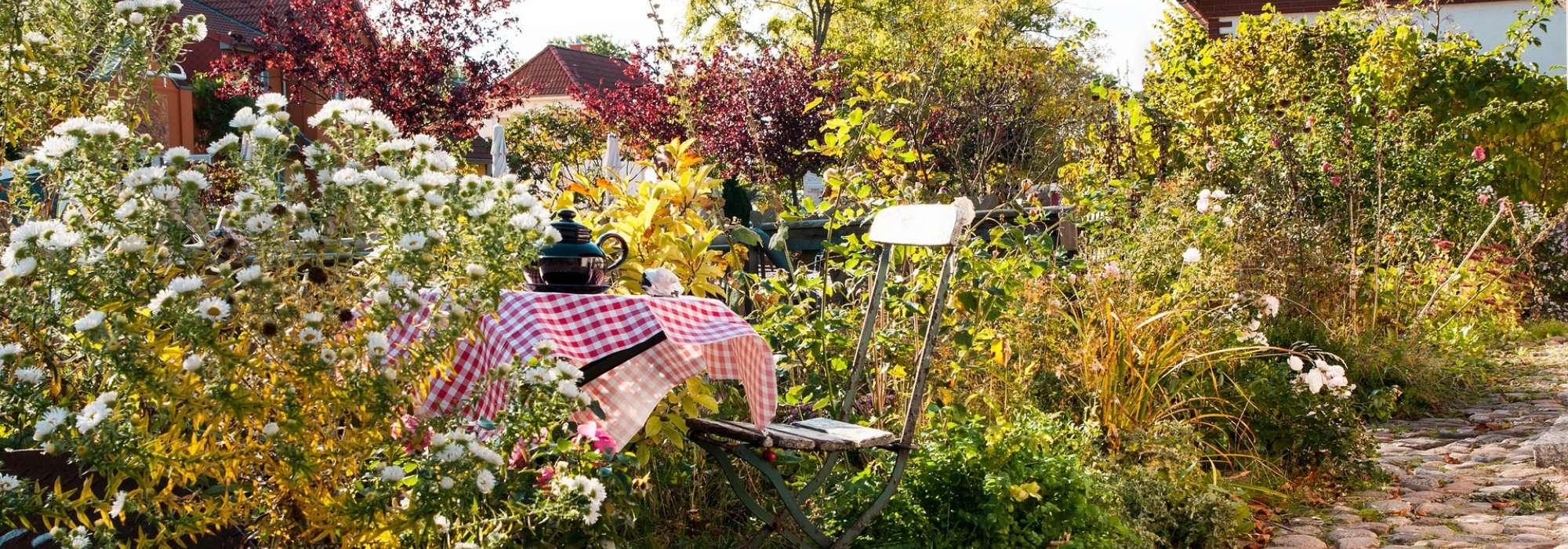
Designing a small garden
in the city or in the countryside, ideas, solutions and tips
Contents
7 out of 10 French people have a garden, but for 40% of them, its area does not exceed 250 m2. In the city or the countryside, the small garden is gradually becoming the norm. Quite challenging to arrange, small gardens often raise questions: how to organise the space? How to make it appear larger? What plants to install?
Discover all the answers to these questions along with our ideas and tips for arrangements, as well as the mistakes to avoid!
I want my garden to look bigger: how to visually enlarge the space?
To create the illusion of a larger garden, there are several possibilities that can be combined.
1/ Divide the space into several zones
Creating two or three spaces in one allows for multiple points of interest, different decor options, colours, or atmospheres, making it appear larger than it actually is. A succession of small, distinct spaces (yet linked by a plant or a “common thread” colour, for example) will help forget the garden’s smallness. The different small spaces can be defined by low walls, semi-transparent fences, or trimmed hedges that take up little space.
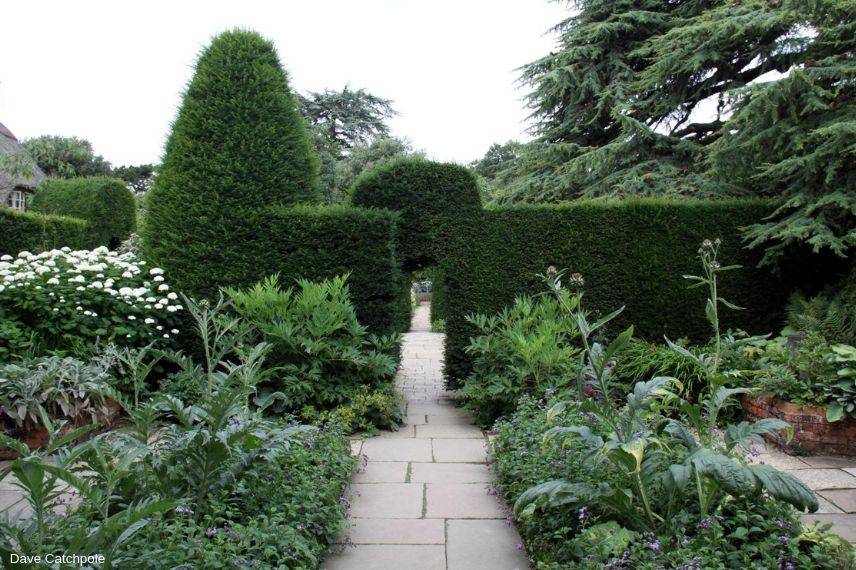
Dividing the garden gives the impression of a larger space while multiplying points of interest.
2/ Consider pathways: organise a circuit
Another way to enlarge the space is to plan multiple paths to reach the same point. This allows for appreciating the garden from different angles. Narrow paths that weave through plant beds slow down progress, forcing visitors to stop and admire the lovely plant combinations.
3/ Play with level differences
Creating different levels is another solution to divide the space and add dynamism to the garden. There is nothing better to enhance the theatricality of a small space.
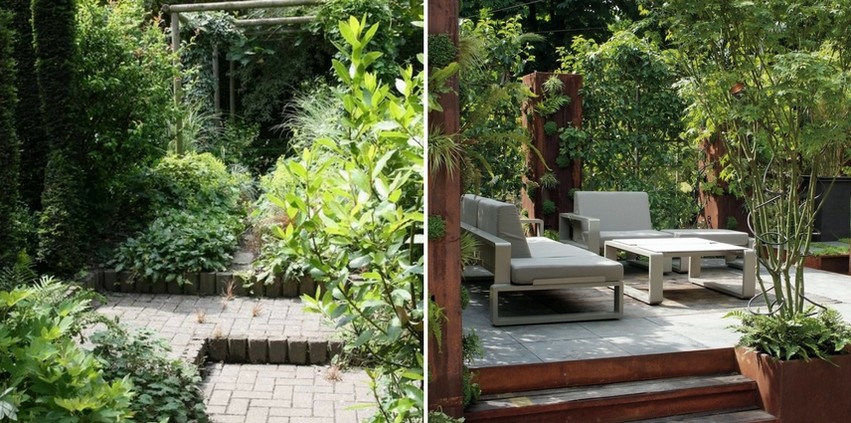
Level variations in the countryside and in the city.
Do not hesitate to create a raised terrace or build some retaining walls that can also serve as seating. If this is not possible in your garden, consider creating raised beds to enhance its appeal and subtly give the illusion of a larger space.
4/ Use lines: verticals… and diagonals
Anything that draws the eye upwards diverts attention from a limited ground space. In a small garden, vertical lines can be represented by plants that grow tall (such as bamboos and all the perennials that reach for the sky like veronicastrums), colourful wooden stakes, a pergola, etc.

From left to right: bamboo Phyllostachys nigra – Veronicastrum virginicum ‘Lavendelturm’
It is also possible to give the impression that the garden is larger than it is by playing with diagonals (laying decking or paving diagonally, for example).
5/ Blur the boundaries and take advantage of the surroundings
To enlarge a small garden, blurring its boundaries is very effective. To do this, conceal walls and fences: it will then be more difficult to know where the garden ends. Use climbing plants and large-leaved plants with graphic shapes in the foreground, and smaller-leaved plants in the background, creating a sense of depth and making the garden more interesting.
Whenever it is worthwhile, appropriate the surrounding landscape: take advantage of the vegetation outside your garden. Use trees and bushes that extend beyond your fence and blend with trees behind, for example.
Tip: the surrounding landscape is not always interesting and can even be particularly unsightly: a building, a structure… It is not always possible to hide them. Then draw the eye to the centre of the garden by placing an object, a sculpture, a fountain, a pond, or even a circular paving, for example.
Finally, if your garden is directly visible from the house, especially from the living room, do not neglect this connection: establish links by adding decorative elements that echo the interior, such as colourful pots or perennials whose colours match your wall or sofa…
6/ Can a perspective be created in a small garden?
In a confined space, looking straight ahead or being captivated by an object or a plant is not always effective. Indeed, in a small garden, the visitor can be entertained by looking around and observing the details. A point of convergence should remain subtle so as not to dominate the design of the space. This could be a plant with decorative foliage amidst other more common-looking plants, for example. However, if you wish to create a perspective, you will need to use seemingly parallel lines that converge at the end of the garden. Our mind then overestimates the distance, making the garden appear longer.
I want my small garden to have everything a large one has: how to arrange the space?
In a small garden, fitting in a terrace, shed, rest or play area, and a vegetable patch requires both foresight and ingenuity. Here’s how to proceed:
1/ Make a plan
In a limited space, a drawing is essential to organise the different areas effectively. You don’t need to be an artist; simply sketch out the garden to define the various spaces, their functions, and how they connect. The plants will then harmonise the whole.
2/ Be clever
If you want a highly versatile garden with multiple functions, the secret is to plan for several uses in the same space. The underside of a seat can serve as storage, the terrace can have a removable section that opens onto a sandpit for children, and the pergola can be equipped with a swing… When it comes to furniture, opt for models that can be stacked or folded. A folding table and chairs allow for occasional outdoor meals, and when stored away, they free up space for sun loungers. Also, try to integrate the various elements of the garden as seamlessly as possible: to blend in, the roof of a shed can be planted with vegetation, a swing set can serve as a support for a wisteria, a rose, or a clematis…
Tip: In a small garden, even the slightest flaws in the finishes of the installations (such as poorly done joints, rough cuts…) are glaringly obvious. Take the time to finish what you start to perfection!
3/ Plant like in nature
To save space, instead of planting the plants side by side, plant them within each other and in layers, mimicking what happens in nature. The space under the bushes can be planted with medium-sized perennials, bulbs, and ground covers. There is no shortage of plants that thrive in this situation! Climbing plants, particularly clematis, can bring a lot of cheer and a seasonal splash of colour to a free or trimmed hedge, among the unfurling shrubs. They climb very naturally among the bamboo. It’s a lovely way to achieve flowers against a backdrop of greenery.
 Make the most of the space by planting in layers
Make the most of the space by planting in layers
Which plants for a small garden?
In a small garden, a tree can be a blessing or a curse, and sometimes even both! Its shade is welcome during the heat of summer, but it can be a burden for the rest of the year. You need to choose it carefully: cherry trees (Prunus) and apple trees (Malus) root deeply and allow a wide range of plants to thrive beneath their leaves. Finally, Japanese maples are a boon for small gardens as most remain small and have an original habit.
When it comes to bushes, there are very compact varieties such as dwarf varieties like Berberis thunbergii ‘Atropurpurea Nana’ or Pittosporum tobira ‘Nanum’. Also consider columnar trees and shrubs like Prunus serrulata ‘Amanogawa’ or Malus ‘Van Eseltine’. Other shrubs also lend themselves well to pruning and remain tidy. Note the yews, which are perfect subjects for topiary. Don’t forget climbing plants that can dress up walls, including: clematis, climbing roses…
Feel free to check out our article on this topic: “A wall in the garden, our ideas for dressing it up“.
Finally, it is difficult to achieve year-round attractiveness in a small space, but with a little ingenuity, it can be done. Make sure to plant plants that have multiple interests throughout the year: flowering, decorative foliage or autumn colours, fruiting, coloured wood, etc. Foliage also allows for composition with its variations in shapes (broad leaves, elongated, highly dissected…) and textures (fuzzy leaves, smooth…), playing with shades of green (dark green, chartreuse…), and purple and golden foliage.
Lastly, do not neglect plants with evergreen foliage; they should even be prioritised.
Style and Decoration in a Small Garden
1/ Should you choose a style?
Yes and no! Of course, a small garden with a very defined style (English, French, Japanese, naturalistic, etc.) will have a strong impact, especially if it aligns with the immediate environment and the architecture of the house. But, don’t rush into it; don’t make it an obligation either. The important thing is that the atmosphere of this living space reflects you. To achieve this, consider the needs of each family member: a relaxation area, a dining corner, a play area for the children… The success of a garden lies in balancing everyone’s aspirations.
2/ How to decorate your small garden?
With limited space, it’s better to reduce the visual complexity of a garden. Designing a garden is partly about coherence and structure, as well as organisation and visual clarity. In small gardens, materials, furniture, and decorations should be treated holistically to allow the plants to be arranged optimally. Using a single material for pots and planters is a good start for coordination, as is a simple paving using one or two shapes at most.
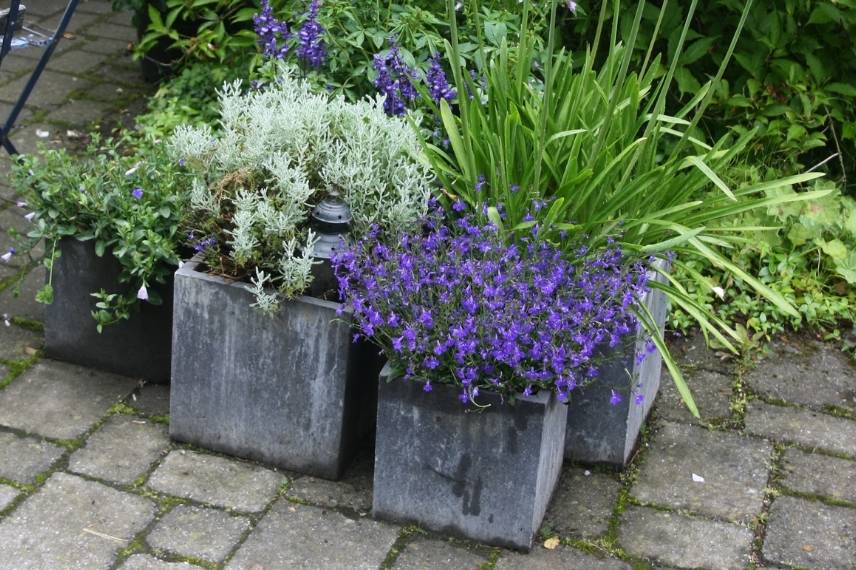
Good coordination: a single type of paving and the same material for the pots
On the other hand, it’s important to unify the entire garden but at an intimate level by adding details and surprises that will encourage exploration of the garden: the more there is to see, the longer the visit will be. This could be plants, sculptures, or materials.
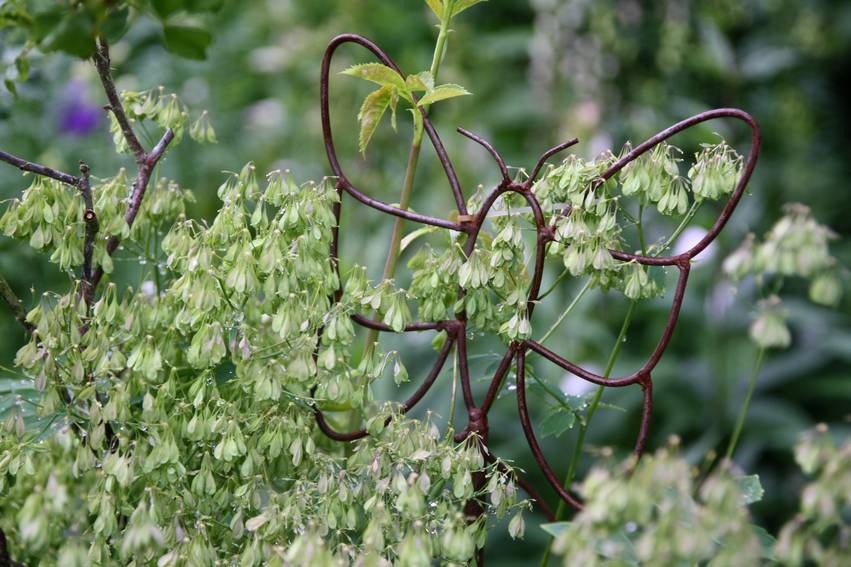
A garden visit can be punctuated with details that catch the eye and slow down progress
Mistakes to Avoid in a Small Garden
1/ Wanting a short grass meadow at all costs
In a small garden, the short grass meadow occupies a significant space and greatly reduces planting possibilities. When used intensively, it quickly takes on an appearance that leaves much to be desired. You can absolutely have a lovely garden without a short grass meadow. Replace it with wooden terraces, paved areas, or use alternative plants to grass!
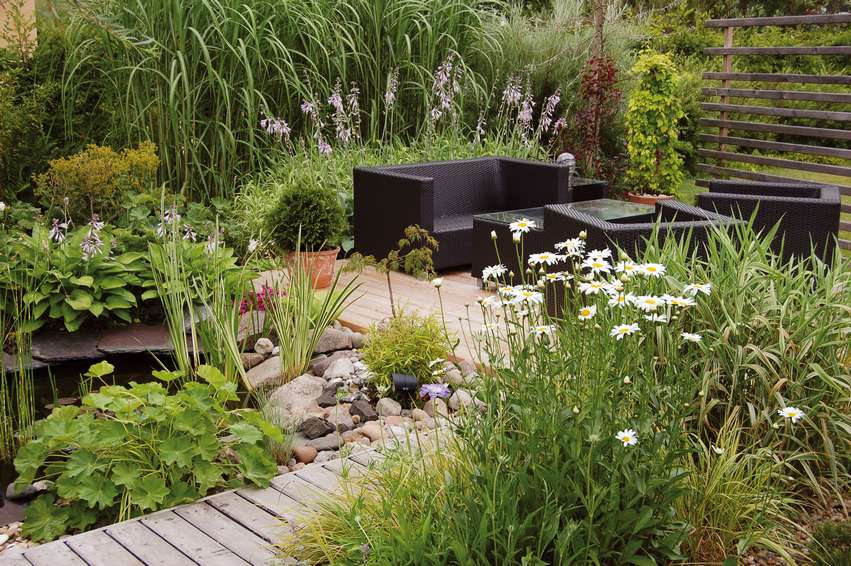 A garden space without grass!
A garden space without grass!
2/ Small garden = small flowerbeds and small plants
Just because your garden is miniature doesn’t mean you have to choose exclusively small plants with small flowers, planted in small flowerbeds! You could plant more, certainly, but the result would hardly be aesthetic. As in a classic garden, the flowerbeds and borders should be as large as possible. This creates good depth and allows the plants to be tiered, giving your space the same look as a normal-sized garden.
3/ I love everything = I plant everything!
Don’t plant just anything! Space is limited, each plant must have an impeccable curriculum vitae, and plants deemed too invasive should be excluded. Prefer plants and varieties that spread slowly and remain compact.
For example, Lysimachia clethroïdes quickly takes over space, while Lysimachia ephemerum spreads slowly and is better suited for a small garden.
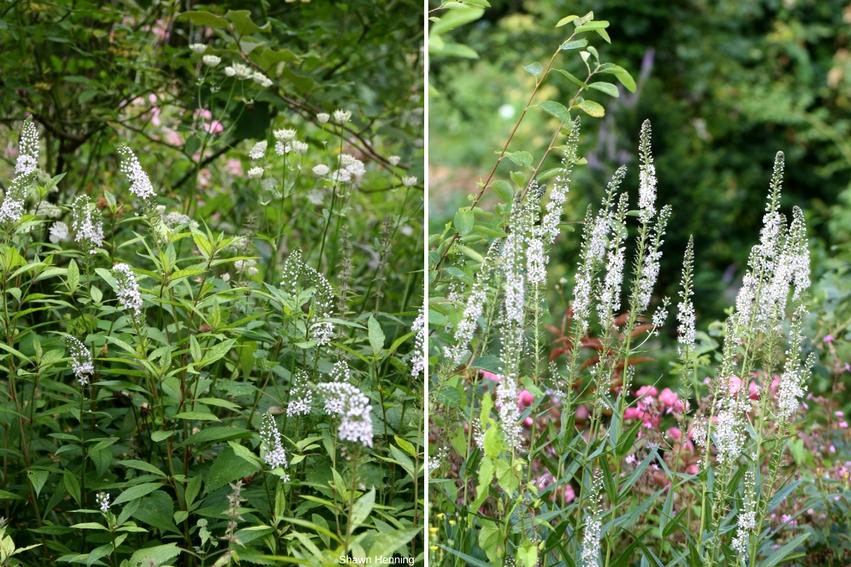 From left to right: Lysimachia clethroides – Lysimachia ephemerum (The Sainte Anne Garden)
From left to right: Lysimachia clethroides – Lysimachia ephemerum (The Sainte Anne Garden)
- Subscribe!
- Contents































Comments